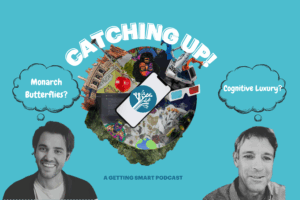From Turn-It-In to Posting, Publishing, Presentation, & Portfolio

New college and career ready expectations require close reading and persuasive writing across the curriculum. Simply requiring kids to turn in more writing won’t work–not for students or teachers. Engaged students and deeper learning require a shift from a turn-it-in compliance culture to an environment where students are posting blogs, producing publications, and making presentations.
For the last few decades, assessment in American education meant an end of unit quiz or end of year test. But experts in competency-based learning suggest that assessment should be a meaningful and a positive learning experience for students. Rather than assessment of learning, the 20 schools profiled in Deeper Learning for Every Student Every Day use assessment for learning. Their curriculum is a sequence of performance tasks and they ask students to make frequent “high stakes” demonstrations of learning to authentic audiences.
Students do their best work when the audience is real, live or online. When their work will be seen and viewed by many people, the student knows the work matters, the work is of value, and that they should do their best. In the student’s mind, there is a distinction between turning something in for the teacher versus turning something in for the greater public. Schools engage students and promote deeper learning use the 4 P’s of next gen learning: posting, publishing, presenting, and portfolio.
Posting. Students should be blogging about their learning every week. In addition to posting to their own sites, they can blog for community news organizations, sports websites, movie review websites, and online teen art communities. Posting publicly allows students to dive into niche interests and explore those interests online, and then offer up their best writing to a community of people they value. For example, one of my students Maya was a regular contributor to a website called Deviant Art. She posted her art and interacted with others on the website regularly, and this provided a way for her to interact with others that shared her interests, and provided a high stakes and real world audience for her to share her talents. This turned into a powerful school project when Maya began turning her art hobby into a business, where she began creating custom animae characters for others on the website – and she actually made money doing it. (See a Susan Lucille Davis post on Why Students Value Blogging.)
Presentation. Students should present in student-led conferences, project-related presentations, and annual exhibitions of learning to large audiences. Presentations to a larger audience is a game changer. Authentic audiences can include guests from the local school district, mentors from the community, teachers from within the school, and of course, student peers, who often hold the bar rather high for their fellow students. Public presentations give students an opportunity to learn how to speak in front of others, and there’s also no way to “skirt around” a public assessment of this form. A student can’t hide. It requires students to be front and center. Of course, this can cause some anxiety for students, so for the first few times a student does this, they need to be given ample time to practice and opportunities to watch other students in action.
Publication. Students should be encouraged to publish their work. The publications could be school-based or out in the community. School-based settings include publications in an online school newsletter or community newsletter, or writing for the yearbook or for a play that will be performed in drama class. Students at Palo Alto high produced 7 world class publications covering news, sports, and public affairs (see Esther Wojcicki’s description.)
The student’s writing could also be published in business or community organization. For example, I have had numerous students who have interned at various businesses, and they have helped establish and write website content for the businesses or produce pamphlets and brochures for advertising and marketing purposes for the business. This kind of publication is wonderful, as it’s a great example of how adults utilize the written world in real world settings. We write to capture other’s attention, to sell products, to attract people to come to our business, to drive traffic on our websites, etc.
Portfolio. Schools are increasingly moving towards digital portfolio options where students and teachers can store student work in the cloud and the work can be accessible anytime and anywhere. Students are often required to put together portfolios in various classes and for project based learning work compilations. I’ve seen students have great success tracking and keeping all college readiness work in a digital portfolio. Imagine if a student began tracking his or her college readiness work beginning in the 7th grade and continuing up through the 12th grade. The portfolio could contain student resumes, informational interviews at various internships and/or for jobs, essays for college and scholarships, research related to colleges and majors, college testing preparation, career explorations, and post high school vision statements, among other content. This could be something that students could have access to even if they moved schools or moved across the country, since digital portfolios live in the cloud. The emerging use of cloud technology by school districts truly means that students can access their work anytime, anywhere, and they can receive (and act upon) feedback from teachers or their parents or peers in real time.
The toolset for digital portfolios continues to improve. See features on eduClipper,Pathbrite and Google Docs.
Presenting, posting, publishing, and portfolios allow for active student engagement and deeper learning in real-world, authentic work. Transform your school culture with the 4 P’s: posting, presenting, publishing, and portfolio.







0 Comments
Leave a Comment
Your email address will not be published. All fields are required.